Warships are the most visible part of naval power, pictures of military might. However, they are not capable of operating alone. The ability of a navy to operate worldwide and at a high tempo is ultimately dependent on auxiliary ships, which keep the fleet supplied with oil, food, and all of the other paraphernalia required to run a warship.
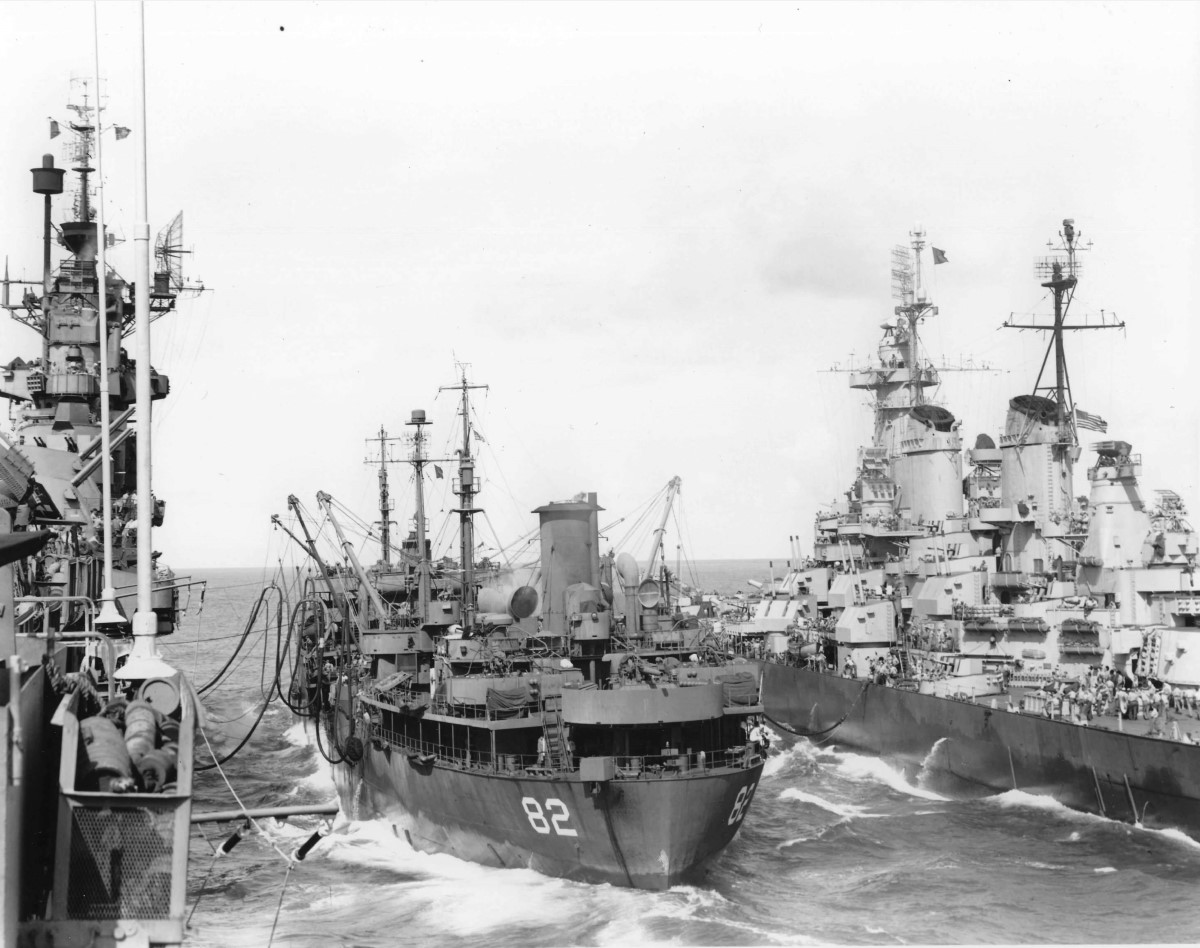
Iowa refueling from USS Cahaba
The modern auxiliary ship is a surprisingly recent innovation, although it has precursors going back to the age of sail. The Royal Navy, blessed with a worldwide network of bases, had little need for a seagoing support train. The USN, beginning during the Spanish-American War, found itself in a very different situation. That war revealed the inadequacy of the USN's support system, as the Asiatic Squadron found itself dependent on British coal supplies, while the blockade of the Cuban port of Santiago was hampered by the need for coal, even after Guantanamo Bay was captured for use as a base. In the aftermath of the war, the US planned for two major threats: an assault into the Caribbean by a European power (most likely Germany) and an attack by Japan on the Philippines. In both cases, the US would have to fight at great distance from its bases. The most famous result was the long ranges of US warships, but even a battleship couldn't carry enough fuel to avoid the need for a forward base.
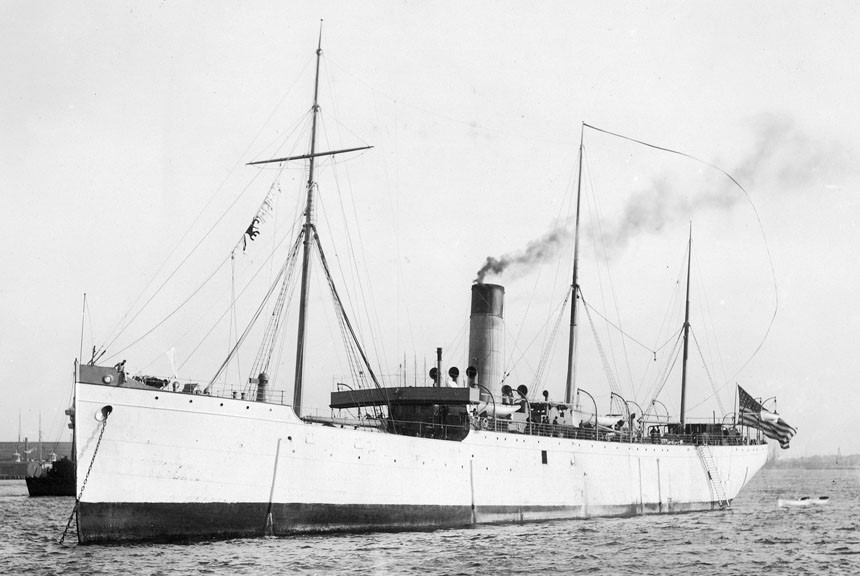
USS Culoga, tender for the Great White Fleet
The world cruise of the Great White Fleet emphasized these lessons. The fleet required 430,000 tons of coal, mostly supplied by chartered foreign colliers. Problems with these colliers lead to an interest in building fast colliers capable of accompanying the battlefleet. In 1908, the procurement of 5 colliers ended up accounting for more than half of the Navy's shipbuilding funds, the only time spending on auxiliaries has ever exceeded warship spending. However, these ships would still require a safe anchorage to transfer coal1 which meant that the fleet would lose considerable time shuttling back and forth.
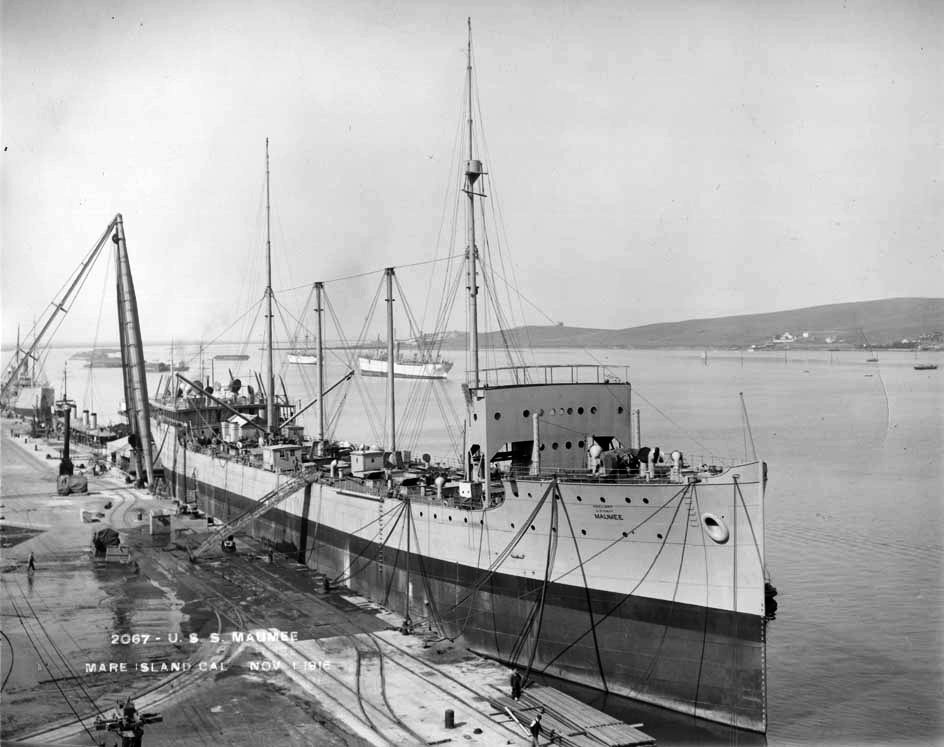
Maumee fitting out at Mare Island
The arrival of oil fuel meant that the USN needed new ships to supply the new battleships with fuel. These ships, known as oilers, were originally intended to provide fuel only when anchored, like their coal-bearing counterparts. Maumee, one of the first pair ordered in 1912, had a remarkable career. She was the first USN vessel to use diesel propulsion,2 an effort spearheaded by a young Chester Nimitz. Nimitz later served as her first Executive Officer3 and was responsible for an innovation that proved crucial when he led the Pacific Fleet against Japan a quarter-century later.
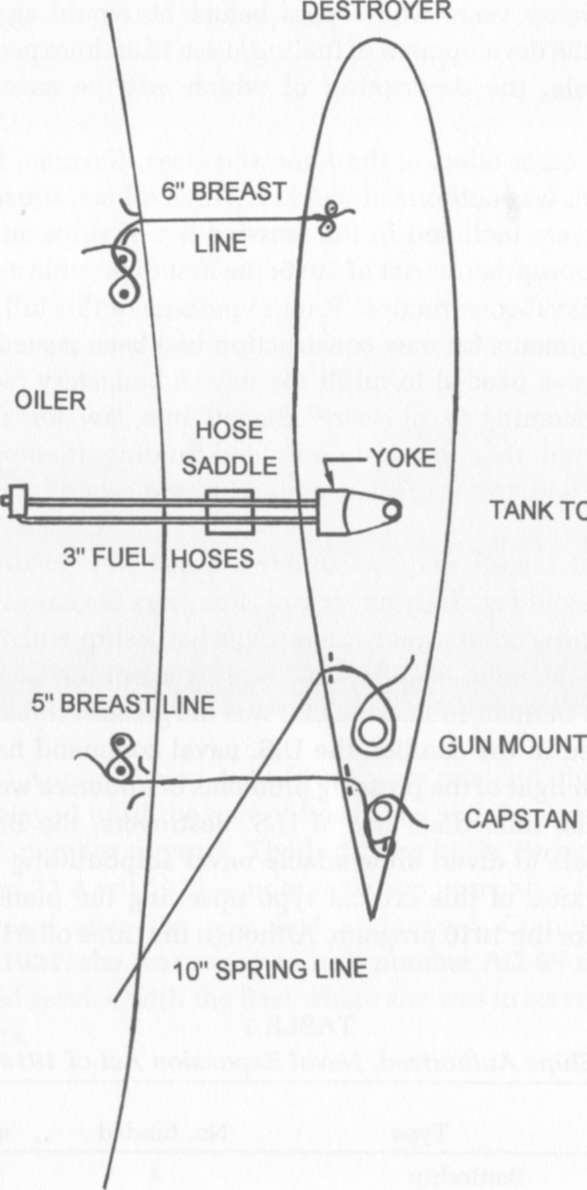
The refueling method devised by Nimitz aboard Maumee
In 1917, when the US entered World War I, destroyers were urgently needed in European waters to combat the U-boat threat. Unfortunately, most US destroyers did not have the endurance to cross the Atlantic on their own. Maumee was ordered to prepare to refuel a squadron of destroyers in the open ocean 300 miles south of Greenland, and Nimitz was responsible for producing the necessary equipment. Each destroyer was towed alongside the oiler, and a pair of 3" fuel hoses were rigged into her tanks. All six destroyers were fueled successfully in 10 hours and 35 minutes, despite a heavy swell and the total inexperience of everyone involved.45
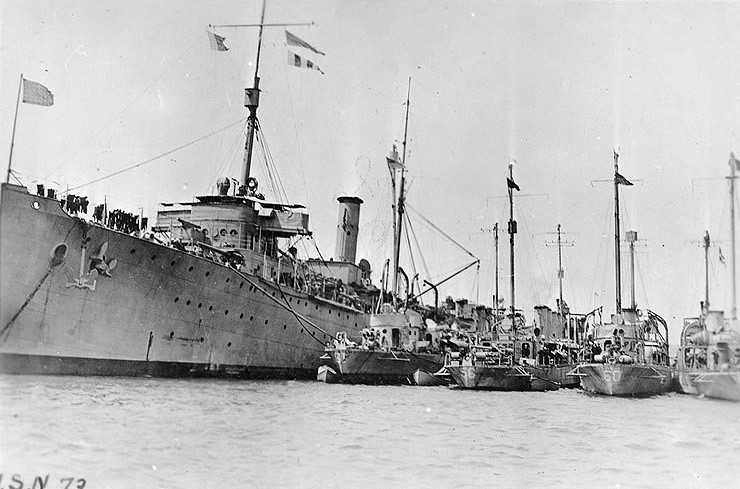
USS Melville tending destroyers off Queenstown
On arrival in European waters, the destroyers found themselves based at Queenstown, Ireland, a port without extensive facilities. Destroyers at the time were very primitive, lacking the capability of larger warships to maintain themselves, or even to support their crews comfortably over the long term. To solve this problem, the USN had built ships, known as destroyer tenders, designed as mobile bases for destroyer flotillas, which were also dispatched to Ireland. Destroyer tenders were fitted with extensive workshops and the men to operate them, as well as extra supplies and ammunition, and facilities for the destroyer crews. Even such basics as food and medical care were supplied by the tender when in harbor.
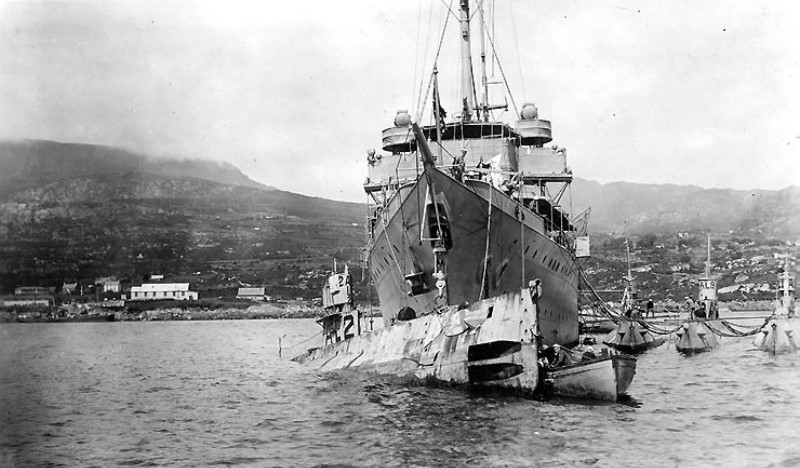
USS Bushnell hoisting submarine L-2 in Irish waters6
American submarines soon joined the destroyers in Ireland, bringing with them their own tenders, for the same reasons as the destroyers. The broad outlines of the tenders were very similar, but the specialized needs of the submarines, such as their internal-combustion engines, as opposed to the steam turbines of the destroyers, meant that separate ships were used. Tenders also served as flagships and administrative headquarters for the flotillas.
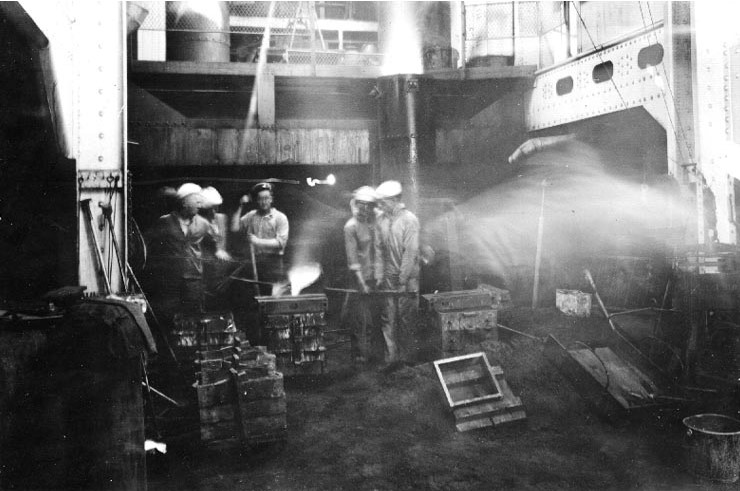
Foundry aboard repair ship Prometheus
While tenders provided supplies and support to their charges, bigger ships would also need more than oil and coal at an advanced base. To support them, the USN developed several types of vessels. Repair ships were built or converted to fix damage aboard larger ships that exceeded their internal resources. This covered a staggering array of fields: boiler shops, a foundry, blacksmithing, carpentry, coppersmithing, electrical repair, pipefitting, hull plating repair, welding, machine shops, and optical repair. Stores ships carried and distributed refrigerated food. Most also carried other supplies, a role shared with conventional transports. Ships converted into floating hospitals were to take off those in need of more medical care than could be provided aboard the warships of the fleet, and evacuate them from the combat zone. These ships were protected under the Hague Convention, provided they were unarmed, took all casualties that came aboard, and were painted white with red cross markings. Some hospital ships were quite primitive, with facilities limited to those required to keep the patient stable during evacuation, while others were fully equivalent to a naval hospital ashore.7
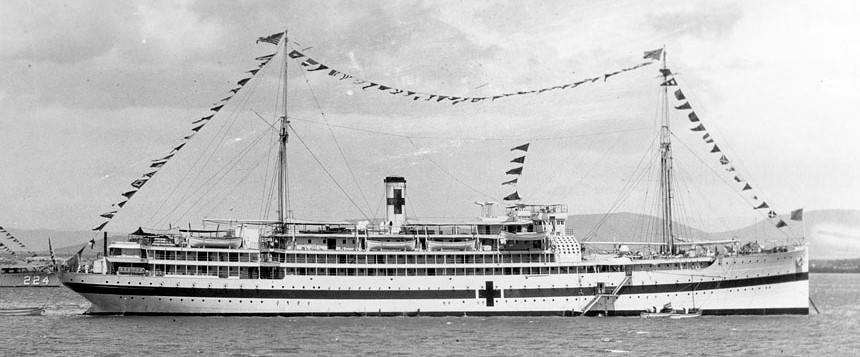
Hospital ship USS Relief
But the auxiliary wouldn't come of age until WWII, when the US Navy's support ships proved critical to the effort that defeated Japan. Refueling at sea became routine, and a bewildering array of ships were developed to keep the fleet operational in forward areas. Eventually, ships would be supplied entirely at sea, and auxiliaries continue their unglamorous but vital work today.
For an excellent look at the USN's oilers, see Grey Steel and Black Oil.
1 There were experiments in replenishment of coal underway, and some were even fairly successful, but none saw widespread use. Ships did sometimes come to a stop at sea and coal that way, but it was an exceedingly awkward and unpopular procedure. ⇑
2 Colliers had been the testbeds for both geared turbines and turboelectric drive in USN service. They were large enough to fit the systems, and would give them constant use, but not so important that unreliable machinery would have been unacceptable. ⇑
3 Naval speak for second-in-command. ⇑
4 After the war, Maumee was placed in reserve in 1922, probably due to the maintenance burden of her engines. In 1942, she was reactivated and refitted with a conventional steam plant. She then served throughout WWII. In 1948, she was transferred to Taiwan, where she survived until 1967. ⇑
5 While this is often cited as the first operational use of refueling at sea, the British fueled some of their oil-burning destroyers from the Queen Elizabeth class battleships in the North Sea. Unfortunately, I have no information beyond the bare fact that it happened, with the destroyers towed behind the battleships. It's almost certain that this happened from very early in the war. ⇑
6 This appears to have been done so maintenance work could be performed on the torpedo tubes. ⇑
7 These were also the only ships of the era that I'm aware of which carried women as part of the crew, serving as nurses. On the purpose-built USS Relief there were special facilities to ensure their privacy, including a dedicated sunbathing deck. ⇑

Comments
What do the carpenters do on a warship? I would have thought that since wood is flammable, they would do as much as they can to keep it for only the most temporary of uses, like temporarily bracing a patch.
Or are they just called carpenters because that's what they called them in the age of sail and wood, and now they do something totally different, but you don't change the name because we've been doing it that way for three hundred years?
No, they're real carpenters, working in wood. While they do attempt to keep wood use to a minimum (all the furniture in Iowa's captain's cabin is painted metal, done well enough that I didn't realize it for a month after I started there), it's still the best for temporary structures. The most obvious example is shoring bulkheads and the like, but I suspect they also did a fair bit of other utility work. Take the boxing ring I showed a picture of in the Life Aboard Iowa post. I'd guess the carpenters were responsible for that. Even a ship as big as Iowa has limited storage space, which probably means a lot more making things as needed. I don't have a full TOE, so I can't say how many carpenters were aboard.
On a repair ship, you're looking at things like external patches to let ships limp back to the states, or more extensive shoring. Even stuff like scaffolding might have been carpenter work.
Did any powers ever see fit to operate a non-Hague-protected hospital ship? I wonder this since apparently the Russian hospital ship's mandated lights gave the fleet away at Tsushima.
And could one switch a ship back and forth? That is, could Russia have sent the ship unmarked, accepting the risk of an attack on it, then repainted it once it made port?
Yes. The British have done so on a couple of occasions. First, during the Falklands, they ran a major hospital on one of their troop transports (I think it was Canberra, but don't want to look it up now) despite having a hospital ship, because they had an agreement with Argentina that anyone who went to the hospital ship had to stay out of the fight for the duration. Second, they later set up RFA Argus as a hospital, but called it a Primary Casualty Receiving Ship because they wanted to be able to use it for non-Hague-allowed things.
I don't know what the requirements for setting up a hospital ship are, and I don't know as much about Tsushima as I should. Haven't gotten around to it yet.